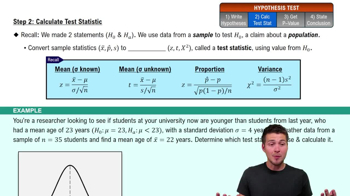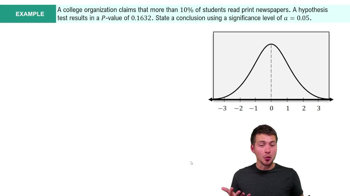Here are the essential concepts you must grasp in order to answer the question correctly.
t-Test
A t-test is a statistical method used to determine if there is a significant difference between the means of two groups. It is particularly useful when the sample size is small and the population standard deviation is unknown. In this context, the t-test will help assess whether the mean weight of the sampled Hershey's Kisses significantly differs from the claimed mean of 4.5333 g.
Recommended video:
Step 2: Calculate Test Statistic
Significance Level
The significance level, often denoted as alpha (α), is the threshold for determining whether a result is statistically significant. In this case, a significance level of 0.05 indicates that there is a 5% risk of concluding that a difference exists when there is none. If the p-value obtained from the t-test is less than 0.05, the null hypothesis can be rejected, suggesting that the mean weight differs from the claimed value.
Recommended video:
Step 4: State Conclusion Example 4
Null Hypothesis
The null hypothesis (H0) is a statement that there is no effect or no difference, serving as a starting point for statistical testing. In this scenario, the null hypothesis posits that the mean weight of the Hershey's Kisses is equal to 4.5333 g. The outcome of the t-test will either support or refute this hypothesis, providing insight into the accuracy of the weight claim on the product label.
Recommended video:

 Verified step by step guidance
Verified step by step guidance Verified video answer for a similar problem:
Verified video answer for a similar problem:



 6:21m
6:21m